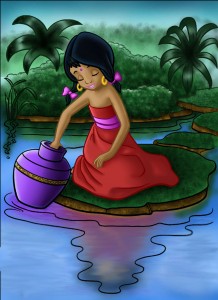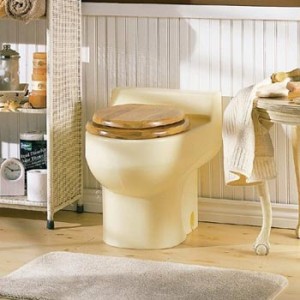
Growing up, I never thought twice about the sustainability of our bathroom habits. Why should I have? Everyone else did the same thing. I mean, we all do it this way because the best way has evolved out of hundreds of years of trial and error, right? Not necessarily. In fact, our modern bathroom practices could stand for a lot of improvement if we want to ensure a nice place to live for our descendants.
Disposables
Americans use a lot of disposable stuff in the bathroom, but not much of it is necessary.
Tissue Paper
The easiest disposable to kick is tissue paper. You really don’t need to blow your nose in paper and throw it away. You can use a traditional hankie, or you can make smaller, single use hankies out of old receiving blankets, t-shirts, sheets, anything. Just cut them into a square and serge if it’s a woven fabric. If you use t-shirts, you don’t even have to sew them. The best part isn’t even that you are saving trees and reducing waste, it’s that they don’t blow out or get soaked when you use them, which means your hands stay cleaner. After using my little hankies, I have to be pretty hard-pressed to actually use paper to blow my nose. I guess I’ve been spoiled.
Toilet Paper
Toilet paper is a little tougher. How do people in less Westernized places do it? Usually the hand or some sort of vegetation. I’m not telling you to do that, but in case you go to India, Africa, or the Middle East, this is why you should only take food or pass objects to others with your right hand. The most practical step you can take is to switch to a better toilet paper. I like Seventh Generation unbleached recycled toilet paper. If you want to take it a step further, check out my post on family cloth. Family cloth is easier if you already cloth diaper, and many people only use it for number one. Even so, it still saves a lot of paper.
Feminine Sanitary Products
I had no idea there were better options until a couple years ago when I was fed up with the waste and cost of disposable feminine hygiene products and finally started searching online. What I found astounded me. It astounded me, because I couldn’t believe these products aren’t better known. How had I never seen a commercial for them or heard about them from friends and family? Because there are no commercials, and my friends and family didn’t know about them. What a shame, because menstrual cups are the bomb.
Women, please, if you have never heard about menstrual cups, look them up. Read the reviews on Amazon, and watch YouTube videos. I’ll save the gritty details so as not to scare away the male readers, but once you get over the initial shock of discovering you have to get your fingers a little dirty, you’ll most likely also love the idea.
Fabric pads are another option. You can make your own or buy them. Many stay-at-home moms make what are commonly called mama cloth. Or you can buy them at Amazon, Etsy, and natural boutiques. They are expensive, but it is an initial investment that will eventually save you plenty of cash. If you’re handy with a sewing machine, you can also make your own (I recommend upcycling old clothes) using one of many tutorials available on the internet.
Not only are these two options better for the environment, they are also healthier for your body. They can even result in a more tolerable monthly time with fewer cramps and accidents.
Water Use
People in severely desertified areas of the world survive on less water a day than we use in one toilet flush. In Rajasthan, India, villagers use an

average of four liters of water a day. This free documentary will give you a little perspective. It doesn’t matter how much money a flush saves. It is all about preserving this precious, irreplaceable resource. If you think that the issue of water conservation does not affect you because you live near plentiful water, you are mistaken. It will not stay there forever. If we continue to use water unwisely, cut down trees, and drain away rain, our lakes, streams, aquifers, and wells will dry up. This is already happening everywhere.
We are treating water to drinking quality, pooping and peeing in it, and flushing it back down the drain to be treated again. Treating water requires immense amounts of energy, as does pumping it through all the pipes. I’m sure you’ve heard the adage, “If it’s yellow, let it mellow. If it’s brown, flush it down.” This is a good start to conserving water. Composting toilets are even better (more on this later).
Baths use more water than showers. Showers use more water than a wet wash cloth. Sometimes a shower and soap are necessary, but between these times, just wipe necessary areas with a wet cloth. It saves time and water. When you do take showers, keep them short. Turn the water off while you are washing your hands or face and brushing your teeth. Re-use your towels multiple times. As long as you hang your towel right away, it won’t stink. If you’re drying a clean body, your towel shouldn’t be getting dirty. You can also save your used water (called greywater as long as it’s not from the toilet) in various ways to be reused outdoors. Search “greywater systems” to learn about the more intricate and efficient methods.
Products
The internet is teeming with information in this area. The no-poo craze itself will have you experimenting for years.
Soap
Use a biodegradable soap. Dr. Bronners is one of the best. Everything about this company is pretty amazing. If you get the liquid, save the container, and refill it from bulk drums at the health food store.
Shampoo
You can look up no-poo if you dare. Another option is starting with the most natural, organic shampoo you can find. None of them are perfect. You can also use Dr. Bronners for shampoo. You will just need to do a rinse with vinegar water to restore your hair to its natural acidic state. If you really feel like experimenting, there are many plants with saponins, a natural, soapy substance. One such plant, yucca, is native to much of the Western half of the United States. One of it’s common names is soapweed. The roots contain the highest quality saponins, but the leaves also contain saponins, and when you use the leaves, you don’t kill the whole plant. Over-harvesting of any plants can damage population numbers, so be wise.
Cosmetics
A broad subject, you could spend weeks researching environmentally friendly cosmetics. Use vegetable oil (many prefer coconut) instead of lotion. Hairspray can be made from boiled sugar water. Cocoa powder can be used as bronzer and eye shadow. Let your imagination run wild.
Buy biodegradable and cruelty free cosmetics. Avoid anything with petroleum derivatives (never buy baby oil again). Make toothpaste from baking soda, liquid stevia, tea tree oil, and spearmint oil. It works much better than the store-bought stuff and is less abrasive than even the “sensitive” ones. Look for organic perfumes or use essential oils if you need to have a fragrance; you may even like not using any at all. The bottom line with cosmetics is that the fewer the ingredients and the less processed they are, the better they are for you and the environment. This means DIY is usually an awesome choice. Have fun researching!
Cleaning Products
All you need to clean your bathroom are vinegar and baking soda. I dedicated an entire post to cleaning the bathroom.
In Nature, Waste Does Not Exist
Humans are the only creatures that treat their bodies’ byproducts as waste. In nature, an animal takes in food and water to regenerate its cells. Anything no longer used by the body, then exits the animal and goes back into the natural system to be regenerated into food, water, and living beings (it’s all the same). Many animals let go of their wastes anywhere, and many more choose precisely where to drop them — humans are one of them. But where we choose to put our waste is what makes it waste.
Humanure
We’ve long used animal manure for fertilizer. That’s because poop is one of nature’s built in fertilizers. Human poop is not excluded from that

system. Humanure can, in fact, be properly composted and used in your garden. Composting toilets are constantly being developed. If you are not impressed with the designs out there, perhaps you could join in on the work and contribute your engineering knowledge. Learn about humanure and composting toilets in the popular Humanure Handbook.
Liquid Gold
Urine cannot be composted along with humanure. It’s too high in nitrogen. That last sentence should tell you where I’m going with this. Properly diluted human urine is an excellent fertilizer — one of the most readily available sources of nitrogen you can find. And its free. In addition, the high nitrogen content of urine is one of the biggest problems for waste treatment plants. By simply peeing in a bucket and using it as free fertilizer, you could solve several problems at once. Granted you do not eat too much salt, you are mostly healthy, and you use proper wiping techniques, sanitation should not be an issue with urine.
Not ready to switch to a composting toilet? That’s okay. Start with skipping every other flush and making your future purchases more informed. Every little thing you do will likely bring you joy, and it will end up snowballing into ever greater mindfulness of the planet and those around you. Happy learning!